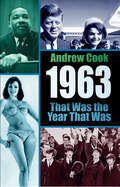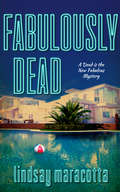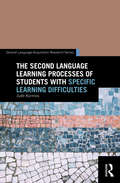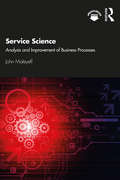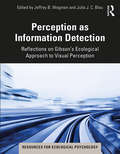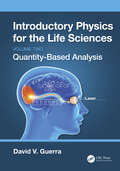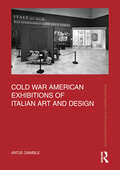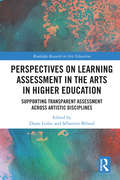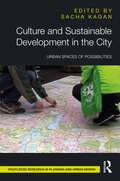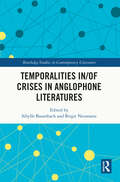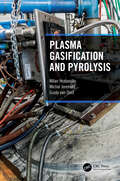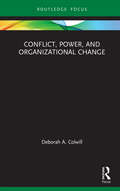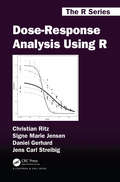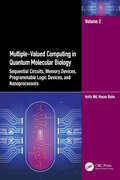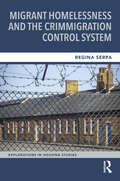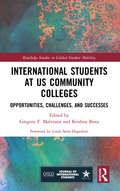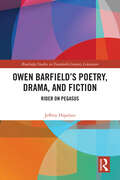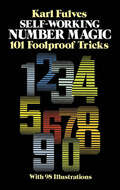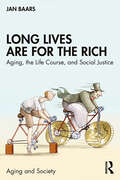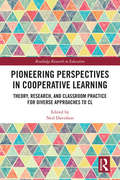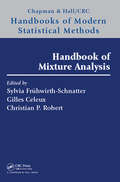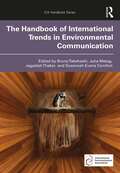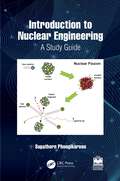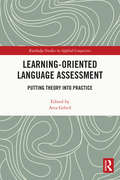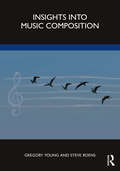- Table View
- List View
1963: That Was the Year That Was
by Andrew CookA compendium of milestone stories and watershed events in popular culture, national and international politics from 1963, including: The Beatles' first No 1, the coldest winter since 1740, Martin Luther King's 'I Have a Dream' speech, the Great Train Robbery, the Profumo Affair, Ian Brady and Myra Hindley's killings, the first woman in Space, Valentina Tereshkova, James Bond becomes an international phenomenon, 70,000 protest against nuclear weapons in London, Harold Wilson's election, and the onset of 'new politics' and satire, the assassination of JFK, the BBC launch of Doctor Who.
Fabulously Dead (A Dead is the New Fabulous Mystery #1)
by Lindsay MaracottaA “Dead is the New Fabulous” Mystery (#1) “Lindsay Maracotta has created in Lucy an exhilarating smart and sassy character. Her insider’s take crackles with fresh insight and laugh-out-loud one-liners.” —Janet Evanovich, #1 New York Times Bestselling Author “Killingly amusing. Lindsay Maracotta wields the sharpest tongue since Nora Ephron banged out Heartburn. The book’s social observations are right on the money.” —The Chicago Tribune In the tradition of Janet Evanovich comes a smart and sassy first mystery about family values—Hollywood style. Animation filmmaker Lucy Frampton seemingly has it all—the glamorous mansion, adorable child and too-handsome-for-his-own-good producer husband. But Lucy has something her famous neighbors do not: a nude, wannabe starlet floating dead in her swimming pool!!! When she and her husband become the prime suspects in the high-profile murder investigation, Lucy knows she’s going to have to clear her own name—especially when she finds out that the enterprising victim had set her sights on Lucy’s husband! In a world of sex, lies, and iPhones, it’s up to Lucy to find the killer…lest she find herself as the next Fabulous victim!!!
The Second Language Learning Processes of Students with Specific Learning Difficulties (ISSN)
by Judit KormosThe Second Language Learning Processes of Students with Specific Learning Difficulties is the only recent book available to offer a detailed and in-depth discussion of the second language learning processes of students with specific learning difficulties (SpLDs). It summarizes research advances in the fields of cognitive and educational psychology and integrates them with recent studies in the area of second language acquisition (SLA). Thus the book is relevant not only to readers who are particularly interested in the role of specific learning difficulties in learning additional languages, but also to those who would like to understand how individual differences in cognitive functioning influence SLA. The book focuses on four important areas that are particularly relevant for language learners with SpLDs: the processes of SLA in general and the development of reading skills in particular, the effectiveness of pedagogical programs, the assessment of the language competence of students with SpLDs and identifying SpLDs in another language. The book also views learners with SpLDs in their social and educational contexts and elaborates how the barriers in these contexts can affect their language learning processes. This is an excellent resource for language teachers, students, and researchers in the areas of second language acquisition and applied linguistics.
Service Science: Analysis and Improvement of Business Processes
by John MaleyeffTo remain relevant in today’s world, practitioners should presume that they have two jobs: first, to do their work effectively so that they provide value to the organization; second, to improve how the work is done so that their organization remains competitive. This book offers clear guidance to excel at this ubiquitous second job.Informed by an appreciation that most personnel that work in any firm, even firms that are manufacturing-oriented, routinely provide services as a key element of their jobs, this book explains how to provide and improve internal customer service, regardless of industry or role. It illustrates the common features, or service process "DNA," while providing a diverse set of examples to enhance understanding. Written by a pioneer in the development of principles and methodologies that address services in a structured and distinctive manner, this book stresses that service processes are distinctly different from manufacturing processes.Rigorous and practical, this book will appeal to students and professionals alike, in business, hospitality, industrial management, public health, and other fields.Online resources include Excel files that act as templates to help with quantitative analysis routines.
Perception as Information Detection: Reflections on Gibson’s Ecological Approach to Visual Perception (Resources for Ecological Psychology Series)
by Jeffrey B. Wagman Julia J. C. BlauThis book provides a chapter-by-chapter update to and reflection on of the landmark volume by J.J. Gibson on the Ecological Approach to Visual Perception (1979).Gibson’s book was presented a pioneering approach in experimental psychology; it was his most complete and mature description of the ecological approach to visual perception. Perception as Information Detection commemorates, develops, and updates each of the sixteen chapters from Gibson’s volume. The book brings together some of the foremost perceptual scientists in the field, from the United States, Europe, and Asia, to reflect on Gibson’s original chapters, expand on the key concepts discussed and relate this to their own cutting-edge research. This connects Gibson’s classic with the current state of the field, as well as providing a new generation of students with a contemporary overview of the ecological approach to visual perception.Perception as Information Detection is an important resource for perceptual scientists as well as both undergraduates and graduates studying sensation and perception, vision, cognitive science, ecological psychology, and philosophy of mind.
Introductory Physics for the Life Sciences (Volume 2): Quantity-Based Analysis
by David V. GuerraThis textbook provides an accessible introduction to physics for undergraduate students in the life sciences, including those majoring in all branches of biology, biochemistry, and psychology and students working on pre-professional programs such as pre-medical, pre-dental, and physical therapy. The text is geared for the algebra-based physics course, often named College Physics in the United States.The order of topics studied in this volume requires students to first understand a concept, such as the conservation of energy, momentum, voltage, or current, the change in a quantity such as entropy, or the rules of ray and wave optics. Then, students apply these concepts to solve problems in the areas of thermodynamics, electrical circuit, optics, and atomic and nuclear physics.Throughout the text these quantity-based applications are used to understand systems that are critical to the understanding of biological systems, such as the entropy of evolution, the signal down the axon of a nerve cell, the optics of the eye, and the operation of a laser.This is part 2 of a two-volume set; volume 1 introduced students to the methods of mechanics and applied these problem-solving techniques to explicitly biological topics such as the sedimentation rate of red blood cells in haemoglobin, the torques and forces on a bacterium employing a flagellum to propel itself through a viscous fluid, and the terminal velocity of a protein moving in a gel electrophoresis device.Key features: Organized and centered around analysis techniques, not traditional mechanics and E&M Presents a unified approach, in a different order, meaning that the same laboratories, equipment, and demonstrations can be used when teaching the course Demonstrates to students that the analysis and concepts they are learning are critical to the understanding of biological systems
Cold War American Exhibitions of Italian Art and Design (Routledge Research in Art Museums and Exhibitions)
by Antje GambleEnriching the existing scholarship on this important exhibition, Italy at Work: Her Renaissance in Design Today (1950–53), this book shows the dynamic role art, specifically sculpture, played in constructing both Italian and American culture after World War II (WWII).Moving beyond previous studies, this book looks to the archival sources and beyond the history of design for a greater understanding of the stakes of the show. First, the book considers art’s role in this exhibition’s import—prominent mid-century sculptors like Giacomo Manzù, Fausto Melotti, and Lucio Fontana were included. Second, it foregrounds the particular role sculpture was able to play in transcending the boundaries of fine art and craft to showcase innovative formalist aesthetics of modernism without falling in the critiques of modernism playing out on the international stage in terms of state funding for art. Third, the book engages with the larger socio-political use of art as a cultural soft power both within the American and Italian contexts. Fourth, it highlights the important role race and culture of Italians and Italian-Americans played in the installation and success of this exhibition. Lastly, therefore, this study connects an investigation of modernist sculpture, modern design, post-war exhibitions, sociology, and transatlantic politics and economics to highlight the important role sculpture played in post-war Italian and American cultural production.The book will be of interest to scholars working in art history, design history, museum studies, Italian studies, and American studies.
Perspectives on Learning Assessment in the Arts in Higher Education: Supporting Transparent Assessment across Artistic Disciplines (Routledge Research in Arts Education)
by Diane Leduc Sébastien BélandDrawing on theoretical and empirical insights from art teachers in Canada and Europe, this edited volume explores the question of how learning in the arts can be effectively and fairly assessed in the context of higher education.The chapters consider a rich variety of assessment practices across music, visual and plastic arts, performing arts, design, fashion, dance and music and illustrate how knowledge, competencies, skills and progress can be viably and fairly assessed. Contextual challenges to assessment are also considered in depth, and particular attention is paid to the challenges of reconciling teaching in the arts, aimed at an intuitive transformation of the student, and assessing learning that takes on its meaning in subjectivity and sensitivity.This text will benefit researchers, academics and educators in higher education with an interest in assessment in the artistic disciplines and in the topic of creativity more broadly. Those specifically interested in educational assessment policy and the visual arts will also benefit from this book.
Culture and Sustainable Development in the City: Urban Spaces of Possibilities (Routledge Research in Planning and Urban Design)
by Sacha KaganThis book exposes the potential to advance a cultural approach to sustainable urban development. It explores urban "spaces of possibilities" and links them to the seized or missed opportunities for innovative forms of transversal partnerships throughout the city and of culturally sensitive urban policies.The call for sustainability brings with it challenges for which, in view of the urgency of social transformation, institutional innovations are necessary. Sustainable urban development will only succeed through creative impulses, experiments, trying out innovative ideas, and making alternatives visible, in particular through locally rooted urban initiatives, artistic actions, and social movements. Discussing many concrete examples from several years of empirical research in the cities of Hanover and Hamburg (Germany), Baltimore and Chicago (USA), Bangalore (India), St. Petersburg (Russia), Singapore, and Vancouver (Canada), the book connects urban spaces and their actors; looks at their guiding principles, strategies, and concrete practices; and identifies new levers, networks, and alliances. Readers will find in this book not only inspiring examples of culture in everyday life in the city but also explanations about the qualities that make local cultural initiatives especially full of potentials, and how they may translate into city-wide changes, engaging with the whole City as Space of Possibilities.The book will interest researchers and advanced students in the interdisciplinary fields of urban studies, sustainability science/sustainability research, cultural sciences, urban sociology, and sociology of the arts/cultural sociology; and those interested in the transdisciplinary collaborations between the arts, academia, and civil society.
Temporalities in/of Crises in Anglophone Literatures (Routledge Studies in Contemporary Literature)
by Sibylle Baumbach Birgit NeumannLiterary works play a crucial role in modelling and conceptualising temporalities. This becomes particularly apparent in times of crises, which put conventionalised temporal patterns and routines under pressure. During crises, past, present, and future appear to collapse into each other and give way to temporal disjunction and rupture. Offering pluralised and context-sensitive approaches to temporalities in and of crises, this volume explores how literature’s engagement with crises suggests both the need for and possibility of rethinking ‘time’. The volume is committed to examining the affordances of specific genres and their potential in pointing beyond temporalities of crises to facilitate a sense of futurity. Individual essays are grounded in recent theories of temporality and literary form, which are related to novel advancements in ecocriticism, queer studies, affect theory, and postcolonial studies. The chapters cover a broad range of examples from different literary genres to reveal the knowledge of literature about temporalities in and of crises.
Plasma Gasification and Pyrolysis
by Milan Hrabovsky Michal Jeremias Guido van OostCurrently, the most widely used treatment of waste is thermal processing, such as incineration. However, thermal plasma technologies offer alternative, cutting-edge, and environmentally friendly processes, which are also considered more energy-efficient and safe. This book provides a comprehensive yet accessible introduction to the process of thermal plasma gasification and pyrolysis.It is an ideal guide for graduate students pursuing further studies in plasma technologies and engineering, in addition to early-career researchers and scientists from related areas looking for material contextual to their own subject matter.Features: Presents an interdisciplinary approach, applicable to a wide range of researchers in waste treatment companies, authorities, and energy and environmental policymakers Authored by authorities in the field Up to date with the latest developments and technologies
Conflict, Power, and Organizational Change (ISSN)
by Deborah A. ColwillA capacity for learning, adapting, and changing is an important facet of organizational resilience. What is involved in generative organizational change? Is it an event, a process, or constantly ongoing? What makes organizational change "good" for the organization? Who has the power to decide what is "good" for the organization and its members? How is it decided? What if there is strong disagreement or conflict? How is that handled? What is the role of organizational members and leaders in these discussions? As these questions demonstrate, the triad of change, power and conflict are intimately linked. The purpose of this book is to explore the topics of change, power and conflict as they relate to the experiences of everyday organizational life. It will provide readers the opportunity to reflect critically on their own local experience and involvement in organizations and to glean actionable wisdom for meaningful engagement and impactful contributions to their organization(s) in the present and future.Conflict, Power, and Organizational Change will be of interest to students, researchers, academics and professional colleagues interested in the fields of business and organizational studies, especially those wanting to get acquainted with the concepts of change, power and conflict in contemporary organizational settings.
Dose-Response Analysis Using R (Chapman & Hall/CRC The R Series)
by Christian Ritz Signe Marie Jensen Daniel Gerhard Jens Carl StreibigNowadays the term dose-response is used in many different contexts and many different scientific disciplines including agriculture, biochemistry, chemistry, environmental sciences, genetics, pharmacology, plant sciences, toxicology, and zoology.In the 1940 and 1950s, dose-response analysis was intimately linked to evaluation of toxicity in terms of binary responses, such as immobility and mortality, with a limited number of doses of a toxic compound being compared to a control group (dose 0). Later, dose-response analysis has been extended to other types of data and to more complex experimental designs. Moreover, estimation of model parameters has undergone a dramatic change, from struggling with cumbersome manual operations and transformations with pen and paper to rapid calculations on any laptop. Advances in statistical software have fueled this development.Key Features: Provides a practical and comprehensive overview of dose-response analysis. Includes numerous real data examples to illustrate the methodology. R code is integrated into the text to give guidance on applying the methods. Written with minimal mathematics to be suitable for practitioners. Includes code and datasets on the book’s GitHub: https://github.com/DoseResponse. This book focuses on estimation and interpretation of entirely parametric nonlinear dose-response models using the powerful statistical environment R. Specifically, this book introduces dose-response analysis of continuous, binomial, count, multinomial, and event-time dose-response data. The statistical models used are partly special cases, partly extensions of nonlinear regression models, generalized linear and nonlinear regression models, and nonlinear mixed-effects models (for hierarchical dose-response data). Both simple and complex dose-response experiments will be analyzed.
Multiple-Valued Computing in Quantum Molecular Biology: Sequential Circuits, Memory Devices, Programmable Logic Devices, and Nanoprocessors
by Hafiz Md. BabuThis book mainly focuses on the design methodologies of various quantum circuits, DNA circuits, DNA-quantum circuits, and quantum-DNA circuits. In this text, the author has compiled various design aspects of multiple-valued logic DNA-quantum and quantum-DNA sequential circuits, memory devices, programmable logic devices, and nanoprocessors. Multiple-Valued Computing in Quantum Molecular Biology: Sequential Circuits, Memory Devices, Programmable Logic Devices, and Nanoprocessors is Volume 2 of a two-volume set, and consists of four parts. This book presents various design aspects of multiple-valued logic DNA-quantum and quantum-DNA sequential circuits, memory devices, programmable logic devices, and nanoprocessors. Part I discusses multiple-valued quantum and DNA sequential circuits such as D flip-flop, SR latch, SR flip-flop, JK flip-flop, T flip-flop, shift register, ripple counter, and synchronous counter, which are described, respectively, with the applications and working procedures. After that, multiple-valued quantum-DNA and DNA-quantum sequential circuits such as D flip-flop, SR flip-flop, JK flip-flop, T flip-flop, shift register, ripple counter and synchronous counter circuits are explained with working procedures and architecture. Part II discusses the architecture and design procedure of memory devices such as random access memory (RAM), read-only memory (ROM), programmable read-only memory (PROM), and cache memory, which are sequentially described in multiple-valued quantum, DNA, quantum-DNA, and DNA-quantum computing. In Part III, the author examines the architectures and working principles of programmable logic devices such as programmable logic array (PLA), programmable array logic (PAL), field programmable gate array (FPGA), and complex programmable logic device (CPLD) in multiple-valued quantum, DNA, quantum-DNA, and DNA-quantum computing. Multiple-valued quantum, DNA, quantum-DNA, and DNA-quantum nanoprocessors are designed with algorithms in Part IV. Furthermore, the basic components of ternary nanoprocessors such as T-RAM, ternary instruction register, ternary incrementor circuit, ternary decoder, ternary multiplexer, ternary accumulator in quantum, DNA, quantum-DNA, and DNA-quantum computing are also explained in detail. This book will be of great help to researchers and students in quantum computing, DNA computing, quantum-DNA computing, and DNA-quantum computing.
Migrant Homelessness and the Crimmigration Control System (ISSN)
by Regina SerpaMigrant Homelessness and the Crimmigration Control System offers new insights into the drivers of homelessness following migration by unpacking the housing consequences of ‘crimmigration’ control systems in the US and the UK. The book advances ‘housing sacrifice’ as a concept to understand journeys in and out of homelessness and the coping strategies migrants employ. Undergirded by persuasive empirical research, it offers a compelling case for a ‘social citizenship’ right to housing guaranteed across social, political and civil realms of society. The book is structured around the 30 life stories of people who have migrated to the capital cities of Boston and Edinburgh from Central America and Eastern Europe. The narratives are complemented by interviews with a range of stakeholders (including frontline caseworkers, activists and policymakers). Guided by the tenets of critical realist theory, this book offers a biographical inquiry into the intersections of race, class and gender and provides insight into the everyday precarity homeless migrants face, by listening to them directly. It will be of interest to students, scholars, and policymakers across a range of fields including housing, immigration, criminology, sociology, and human geography.
International Students at US Community Colleges: Opportunities, Challenges, and Successes (Routledge Studies in Global Student Mobility)
by Gregory F. MalveauxThis volume documents the experiences of international students and recent international initiatives at US community colleges to better understand how to support and nurture students’ potential. Offering a range of case studies, empirical and conceptual chapters, the collection showcases the unique curricula and diverse opportunities for career development that colleges can offer international students.International Students at US Community Colleges addresses issues of student access, enrolment barriers, college choice, and challenges relating to integration in academic and professional networks. Ultimately, the book unpacks institutional factors which inhibit or promote the success of international students at US community colleges to inform faculty, student affairs, administration, and institutional policy. With international students’ declining enrollment, this book considers the measures being taken by community college officials to bring continued access and equity to international students. Offering insights from a range of international scholars as well as on-the-ground case studies, this text will benefit researchers, academics, and educators with an interest in multicultural education, international and comparative education, and higher education management. Those specifically interested in educational policy and the sociology of education will also benefit from this book.
Owen Barfield’s Poetry, Drama, and Fiction: Rider on Pegasus (Routledge Studies in Twentieth-Century Literature)
by Jeffrey HipolitoOwen Barfield influenced a diverse range of writers that includes T. S. Eliot, J. R. R. Tolkien, W. H. Auden, Howard Nemerov, and Saul Bellow, and Owen Barfield's Poetry, Drama, and Fiction is the first book to comprehensively explore and assess the literary career of the "fourth Inkling," Owen Barfield. It examines his major poems, plays, and novels, with special attention both to his development over a seventy-year literary career and to the manifold ways in which his work responds with power, originality, and insight to modernist London, the nuclear age, and the dawning era of environmental crisis. With this volume, it is now possible to place into clear view the full career and achievement of Owen Barfield, who has been called the British Heidegger, the first and last Inkling, and the last Romantic.
Self-Working Number Magic: 101 Foolproof Tricks (Dover Magic Books)
by Karl FulvesNumbers pervade nearly every aspect of our daily lives: telephone numbers, zip codes, Social Security numbers, driver's license and credit-card numbers. We are beleaguered by numbers: no wonder we're fascinated, intrigued, even a bit bewildered by them; no wonder tricks involving numbers are perennial favorites.With Self-Working Number Magic you can perform show-stopping tricks, stunts and routines that are sure to delight audiences because they capitalize on our natural fascination for numbers. Karl Fulves, well-known writer in the field of magic presents 101 baffling tricks that are so easy to do they practically work by themselves. While all the tricks involve basic mathematical principles, the mathematics is not discussed here; rather, emphasis is on performing and perfecting the tricks. They can be learned quickly and put into operation immediately, and best of all, they really dazzle an audience.Among the seemingly impossible tricks and stunts in this book: guessing a spectator's age or how long a married couple have known each other; predicting the sum of a group of numbers and using your brain like a lightning calculator; and instantly memorizing long lists of numbers or things. This selection also includes tricks involving cards, calendars, magic squares, and betting games. The author even suggests stage patter to use while performing.With this book and a modicum of practice, anyone can perform an assortment of number tricks that will astound and delight an audience. Whatever your age or math skills, you'll soon be baffling friends and relatives with over 100 fascinating, foolproof tricks.
Long Lives Are for the Rich: Aging, the Life Course, and Social Justice (ISSN)
by Jan BaarsLong Lives Are for the Rich is the title of a silent ominous program that affects the lives of millions of people. In all developed countries disadvantaged and, especially, poor people die much earlier than the most advantaged. During these shorter lives they suffer ten to twenty years longer from disabilities or chronic disease. This does not happen accidentally: health inequalities – including those between healthy and unhealthy life styles – are mainly caused by social inequalities that are reproduced over the life course. This crucial function of the life course has become painfully visible during its neoliberal reorganization since the early 1980s. Studies about aging over the life course, from birth to death, show the inhumane consequences as people get older. In spite of the enormous wealth that has been piled up in the US for a dwindling percentage of the population, there has been growing public indifference about the needs of those in jobs with low pay and high stress, but also about citizens from a broad middle class who can hardly afford high quality education or healthcare. However, this ominous program affects all: recent mortality rates show that all Americans, including the rich, are unhealthier and dying earlier than citizens of other developed countries. Moreover, the underlying social inequalities are tearing the population apart with nasty consequences for all citizens, including the rich. Although the public awareness of the consequences has been growing, neoliberal policies remain tempting for the economic and political elites of the developed world because of the enormous wealth that is flowing to the top. All this poses urgent questions of social justice. Unfortunately, the predominant studies of social justice along the life course help to reproduce these inequalities by neglecting them. This book analyzes the main dynamics of social inequality over the life course and proposes a theory of social justice that sketches a way forward for a country that is willing to invest in its greatest resource: the creative potential of its population.
Pioneering Perspectives in Cooperative Learning: Theory, Research, and Classroom Practice for Diverse Approaches to CL (Routledge Research in Education)
by Neil DavidsonOffering first-hand insights from the early originators of Cooperative Learning (CL), this volume documents the evolution of CL, illustrating its historical and contemporary research, and highlights the personal experiences which have helped inspire and ground this concept. Each of the chapters in Pioneering Perspectives in Cooperative Learning foregrounds a key approach to CL, and documents the experiences, research, and fruitful collaborations which have shaped and driven their development. Contributions from leading scholars include Aronson, Davidson, Kagan, Johnson & Johnson, Schmuck, the Sharans, Slavin and Madden, as well as retrospective pieces on the work of Deutsch and Cohen. These chapters detail the historical development of cooperative learning, cooperation versus competition, and cover major approaches including the jigsaw classroom; complex instruction; the learning together model, and several more. Chapters include qualitative, personal, and retrospective accounts, whereby authors outline the research and theory which underpins each approach while highlighting practical strategies for classroom implementation.This text will primarily be of interest to professors, researchers, scholars, and doctorial students with an interest in the theory of learning, educational research, and educational and social psychology more broadly. Practitioners of CL with an interest in varied forms of small group learning and classroom practice, as well as those interested in the history and sociology of education, will also benefit from the volume.
Handbook of Mixture Analysis (ISSN)
by Sylvia Frühwirth-Schnatter, Gilles Celeux and Christian P. RobertMixture models have been around for over 150 years, and they are found in many branches of statistical modelling, as a versatile and multifaceted tool. They can be applied to a wide range of data: univariate or multivariate, continuous or categorical, cross-sectional, time series, networks, and much more. Mixture analysis is a very active research topic in statistics and machine learning, with new developments in methodology and applications taking place all the time. The Handbook of Mixture Analysis is a very timely publication, presenting a broad overview of the methods and applications of this important field of research. It covers a wide array of topics, including the EM algorithm, Bayesian mixture models, model-based clustering, high-dimensional data, hidden Markov models, and applications in finance, genomics, and astronomy.Features: Provides a comprehensive overview of the methods and applications of mixture modelling and analysis Divided into three parts: Foundations and Methods; Mixture Modelling and Extensions; and Selected Applications Contains many worked examples using real data, together with computational implementation, to illustrate the methods described Includes contributions from the leading researchers in the field The Handbook of Mixture Analysis is targeted at graduate students and young researchers new to the field. It will also be an important reference for anyone working in this field, whether they are developing new methodology, or applying the models to real scientific problems.
The Handbook of International Trends in Environmental Communication (ICA Handbook Series)
by Bruno TakahashiThis handbook provides a comprehensive review of communication around rising global environmental challenges and public action to manage them now and into the future. Bringing together theoretical, methodological, and practical chapters, this book presents a unique opportunity for environmental communication scholars to critically reflect on the past, examine present trends, and start envisioning exciting new methodologies, theories, and areas of research. Chapters feature authors from a wide range of countries to critically review the genesis and evolution of environmental communication research and thus analyze current issues in the field from a truly international perspective, incorporating diverse epistemological perspectives, exciting new methodologies, and interdisciplinary theoretical frameworks. The handbook seeks to challenge existing dominant perspectives of environmental communication from and about populations in the Global South and disenfranchised populations in the Global North.The Handbook of International Trends in Environmental Communication is ideal for scholars and advanced students of communication, sustainability, strategic communication, media, environmental studies, and politics.
Introduction to Nuclear Engineering: A Study Guide
by Supathorn PhongikaroonIntroduction to Nuclear Engineering serves as an accompanying study guide for a complete, introductory single-semester course in nuclear engineering. It is structured for general class use, alongside fundamental nuclear physics and engineering textbooks, and it is equally suited for individual self-study.The book begins with basic modern physics with atomic and nuclear models. It goes on to cover nuclear energetics, radioactivity and decays, and binary nuclear reactions and basic fusion. Exploring basic radiation interactions with matter, the book finishes by discussing nuclear reactor physics, nuclear fuel cycles, and radiation doses and hazard assessment. Each chapter highlights basic concepts, examples, problems with answers, and a final assessment.The book is intended for first-year undergraduate and graduate engineering students taking Nuclear Engineering and Nuclear Energy courses.
Learning-Oriented Language Assessment: Putting Theory into Practice (Routledge Studies in Applied Linguistics)
by Atta GebrilThis collection brings together research on learning-oriented language assessment from scholars working across geographic and educational contexts, highlighting the opportunities of assessment practices which seek to better align assessment and learning tasks and support effective learning. The volume begins by introducing learning-oriented assessment (LOA) and the context around its growing popularity, especially in accountability-oriented settings which favor summative large-scale tests. The first part of the book charts the development of LOA’s theoretical and conceptual underpinnings, outlining the ways in which they have been informed by theories of learning and key elements. The second part demonstrates LOA in practice, drawing on examples from different countries and instructional settings to explore such topics as the role of technology in LOA and developing feedback materials based around LOA principles and developed for core literacy skills.Offering a holistic view of learning-oriented assessment and the real-world affordances and challenges of its implementation, this book is key reading for graduate students, researchers, and practitioners in language testing and assessment, TESOL, and language education.
Insights into Music Composition
by Gregory Young Steve RoensInsights into Music Composition is a guide and source of inspiration for beginning students of music composition. Drawing on perspectives from a range of experienced composers, the book introduces readers to the compositional process, emphasizing how to think about creating a piece of music from beginning to end by providing not only a survey of methods but also an understanding of the overarching context for composition. The authors present student composers with the tools to develop their own voice, covering topics such as: methods for harnessing inspiration and creativity how to give shape, context, and meaning to a piece of music and create moments that audiences will remember the value in exploring the music of other cultures and music’s interdisciplinarity atonal and 12-tone techniques and the roles of form and style the benefits and pitfalls of student-teacher relationships and the importance of building relationships with performers Combining content from class scenarios with discussion questions, practical exercises, an annotated guide of online resources, and a glossary of terms, the text’s flexible structure allows chapters to be read through in order or drawn on by topic. Clear and accessible, Insights into Music Composition is an ideal resource for all students and instructors of music composition.
